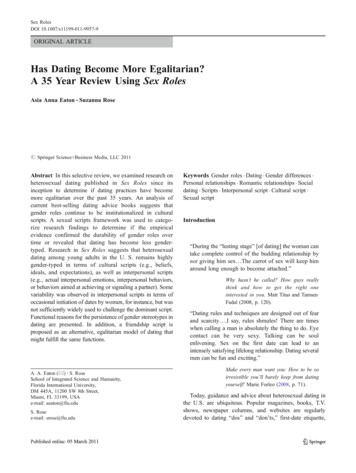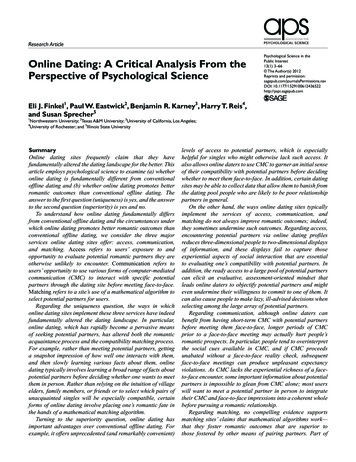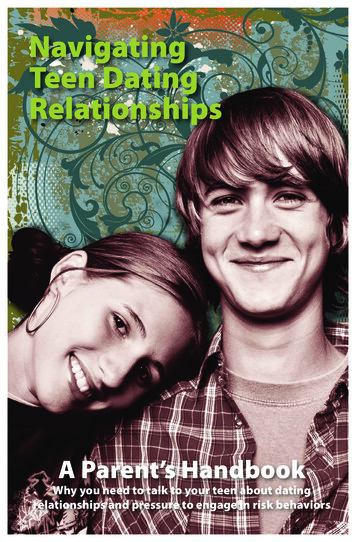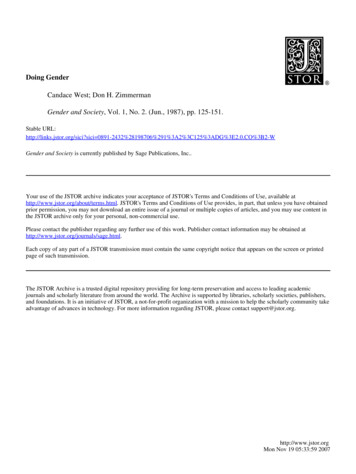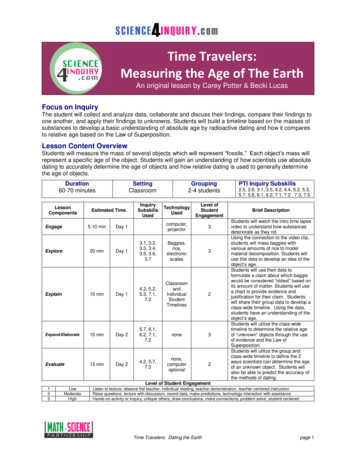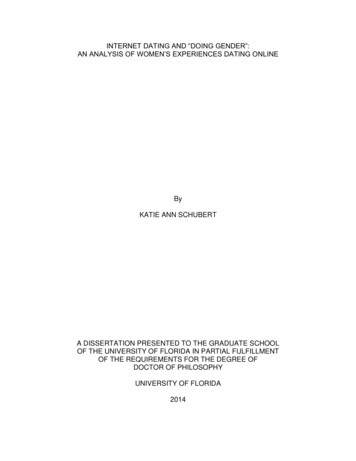
Transcription
INTERNET DATING AND “DOING GENDER”:AN ANALYSIS OF WOMEN’S EXPERIENCES DATING ONLINEByKATIE ANN SCHUBERTA DISSERTATION PRESENTED TO THE GRADUATE SCHOOLOF THE UNIVERSITY OF FLORIDA IN PARTIAL FULFILLMENTOF THE REQUIREMENTS FOR THE DEGREE OFDOCTOR OF PHILOSOPHYUNIVERSITY OF FLORIDA2014
2014 Katie Ann Schubert
To my familyThank you for your support.
ACKNOWLEDGMENTSI thank my parents for their endless support in my educational ventures. Further,I thank all the women who volunteered their time and stories for this research. Lastly, Iwould like to thank my committee for their hard work and patience throughout thisresearch process.4
TABLE OF CONTENTSACKNOWLEDGMENTS . 4ABSTRACT . 7CHAPTER1INTRODUCTION . 9Research Questions . 102LITERATURE REVEW . 12Sociology of Gender . 12Gender and Dating In America . 17Role of Sex in Relationships. 18Gender Scripts . 22Evolution and Mate Selection . 24Partner Perception . 26Role of Gender in Personal Advertisements and Speed-Dating . 27Internet Dating Subculture . 28Internet Dating and Mate Selection Theories . 32Motivations of Internet Daters. 35Culture and Online Dating Sites/Dating Scripts . 37Self-Disclosure and Authenticity in Online Dating . 38Implications . 43Justification for using Qualitative Interviews . 453DATA AND METHODS . 48Participants . 48Interviews . 50Coding and Analysis . 534FINDINGS, PART I: CHANGING GENDER SCRIPTS AND INITIATION . 57Picking out Specific Characteristics . 57Scripted Rules and Expectations . 65Convenient way to Meet Men . 70Conclusion . 745FINDINGS, PART II: DATING EXPECTIONS HAVE REMAINED THE SAME . 76The Importance of “Chemistry”/ the “Spark”. 76Internet Dating is Artificial . 81Men are Just Looking for Sex . 84Conclusion . 895
6FINDINGS PART III: DISCOMFORT/STIGMA/TABOO ATTACHED TOINTERNET DATING . 917CONCLUSION . 96Summary of Significant Findings . 97Areas of Future Research . 103Significance and Contributions of this Study . 104APPENDIXINTERVIEW QUESTION GUIDE . 106REFERENCE LIST. 107BIOGRAPHICAL SKETCH . 1136
Abstract of Dissertation Presented to the Graduate Schoolof the University of Florida in Partial Fulfillment of theRequirements for the Degree of Doctor of PhilosophyINTERNET DATING AND “DOING GENDER”:AN ANALYSIS OF WOMEN’S EXPERIENCES DATING ONLINEByKatie Ann SchubertMay 2014Chair: Connie ShehanMajor: SociologyInternet dating has become much more common in the past decade. This pastJune (2009), dating sites reported 27.5 million unique visitors (Comstock, 2009). It isprojected that in 2011, dating sites in the United States alone will collect a whopping 932 million (JupiterResearch, 2007). Although Internet dating is gaining popularity,there has been very little research done on how Internet dating is changing the waypeople date. I conducted semi-structured interviews with 30 women between the agesof 18-35 and asked them about their experiences dating online. Interviews wereanalyzed using grounded theory and coding of the interview data focused on howparticipants did gender and Internet dating, but focusing on West and Zimmerman’s“doing gender” perspective.My analysis shows that although the way women are doing gender whileparticipating in online dating is changing, women are nonetheless continuing to dogender. The way that women do gender has been altered by the increased use ofInternet dating, but these women continue to adhere to many of the traditionalcomponents of dating, including searching for the hegemonic ideal and the “spark” withtheir potential partner. West and Zimmerman explained that no one can opt out of going7
gender. Although the women interviewed reported doing dating differently with the useof the Internet, doing gender is still a pertinent theme in many of these interviews.Furthermore, many of the women interviewed reported feeling held accountable fordoing gender appropriately, even while engaged in Internet dating.8
CHAPTER 1INTRODUCTIONMost of us who have found our soul mates relied on the randomness of the bar scene orthe party circuit or life in general. This serendipity is culturally important – we have acollective investment in the idea that love is a chance event, and often it is. Butserendipity is the hallmark of inefficient markets, and the marketplace of love, like it ornot, is becoming more efficient.- Rufus GriscomWired Magazine (2002)Throughout history, human beings have courted and intimate relationships havebeen one of the most important pair bonds in society. These facts remain true eventoday. However, the process by which people court and form relationships has beenaltered with the advent of new technologies. One such technology has been the rise ofInternet dating sites. The formation of intimate relationships is becoming increasinglydependent on these online technologies, and because of this, researchers mustunderstand the psychological and sociological intricacies associated with online dating.Researches have long studied how men and women view and treat intimaterelationships differently. The differences we see in regard to gendered performance inrelationships are not static—our society defines how men and women should behave inrelationships. In the past few decades, our society has undergone numerous changespertaining to how people treat and define relationships, the roles people perform in theirrelationships, and how relationships are initiated and maintained. Internet daters are notimmune to these gender scripts. This research will predominantly focus on the genderscripts of online daters in the United States, focusing predominantly on what isdisplayed in dating profiles and the rules associated with relationship formation. In doingthis, the research will use a “doing gender” (West and Zimmerman, 1987) perspective,9
focusing on the ways people behave in accordance with their gender and the types ofsanctions in place when people do not behave accordingly.Despite the growing popularity of the online dating industry, there is still atremendous amount we do not understand about Internet dating and the people whouse online dating services. This research will propose to further these avenues ofthought and contribute to the research on Internet daters and dating. The goal of thisstudy is to better understand gender scripts associated with initiating onlinerelationships. Lawson and Leek (2006) found people who participate in Internet datingfeel more comfortable with the Internet dating process than the traditional datingprocess because they are not expected to adhere to rigid gender stereotypic roles. Ifthis is true, the initial process of Internet-mediated relationships should show lessconformity to traditional gender roles. The interviews conducted in this study will focuson participant’s perception of their own gendered behavior; the ways in which theybehave and the ways in which they believe their date expects them to behave.Research QuestionsEvery culture has unique gender scripts in regard to relationship formation anddating. Although these scripts have changed over time in the United States, they are stillpresent. These scripts are also present when individuals meet and date others with theuse of Internet dating services. This research will attempt to uncover the types of scriptsthat are present when individuals meet online.This research will focus dater’s perceptions about gender and Internet datingrelationship formation. The major focus of the interviews is how female Internet daters“do” online dating. For instance, do initiation strategies differ for women if they are10
dating online versus engaged in more traditional dating styles? How do the beginningstages of Internet-mediated relationships differ from other more traditionalrelationships? Do women feel they are less committed to stereotypical genderedbehavior online? These questions will shed light onto how and when initiation of intimaterelationships occurs. For purposes of this research, initiation will be defined as a) whosends the first message online to begin communication, b) who initiates the first inperson meeting, and c) who asks for the second in-person meeting. The interviews willalso hopefully uncover the implicit gendered “rules” involved in Internet dating (i.e. howmany emails must be exchanged before phone numbers are exchanged, how manyphone calls must be exchanged before a face-to-face date is set up, etc.).11
CHAPTER 2LITERATURE REVEWSociology of GenderThe field of sociology has progressed the understanding of gender in our society.The sociological work on gender sees gender as an institution, frame, or social structureto which everyone in society looks for behavioral guidance.West and Zimmerman (1987) explained that people are constantly “doinggender”, and that everyone is held accountable by others to “do” gender appropriately.The authors explained that “the ‘doing’ of gender is undertaken by women and menwhose competence as members of society is hostage to its production” (p.126). Westand Zimmerman’s “Doing Gender” argued gender is not a set of traits residing withinindividuals, but something individuals do in their social interactions. This behaviorinvolves a “complex of socially guided perceptual, interactional, and micropoliticalactivities that cast particular pursuits as expressions of masculine and feminine‘natures’” (p.126). Gendered behaviors are therefore not rooted in biology, but are socialconstructs reproduced in social interactions.West and Fenstermaker (1995) elaborated on West and Zimmerman’s “DoingGender” in “Doing Difference”. West and Fenstermaker argued there are more complexmechanisms that can explain and produce social inequality. The authors explained thatby taking into consideration race, class, and gender, a more thorough understanding ofan individual’s position and behavior in society can be achieved. As the authorsexplained, “no person can experience gender without simultaneously experiencing race12
and class” (p.13). Race, gender, and class are all accomplished in social interactionswith others and we are all held accountable for behaving within these “categories”.Risman (2004) also built upon the theory that people do gender. Risman arguedthat gender should be conceptualized as a social structure. She explained that by doingthis, our understanding of gender will be advanced in several ways. First, it will helpresearchers analyze the interconnection between gendered selves, the culturalexpectations that help explain interactional patterns, and institutional regulations.Second, the understating of gender as a structure will enrich theory—this concept doesnot attempt to override other theories, but works to compliment them. Third, it will allowus to investigate the direction and strength of causal relationships between genderedphenomenon within many different dimensions. And last, is helps us understandinstitutional change and individual identities. When we begin to take into considerationhow gender inequality is being produced within each dimension, we will be betterequipped to intervene and change the structure. She explains that gender inequalitiesare reproduced in everyday interactions, even if done so subconsciously. Furthermore,cultural gendered interactional experiences make egalitarian heterosexual relationshipsextremely difficult to accomplish. Using structural language will help detangle howinequalities are constructed, recreated, and deconstructed.Also building upon West and Zimmerman’s “doing gender”, Martin (2004)explained that gender is a social institution. She argued that institutions guide the waypeople in a given society live and behave. Classifying gender as a social institutionallows researchers to understand why people continually “do” gender, even when theyare aware of it. Martin also offered several other reasons why framing gender as an13
institution may be beneficial: it affirms gender’s sociality, it directs attention to practices,it highlights power, it reinstates the material body, it acknowledges disjuncture, conflicts,and change, and it challenges the macro-micro separation. The notion that gendershould be conceptualized as a social structure (Risman, 2004) or social institution(Martin, 2004) extended the doing gender perspective. Male and female behavior isreproduced through social interaction. Society provides its members with a blueprint onhow to behave, dress, and think in accordance with their gender. Whether we refer tothis social phenomenon as an institution or a structure, it comes back to West andZimmerman’s notion of “Doing Gender”.Ridgeway (2009) discussed the ramifications of societal members not behavingwithin their gender norms. Ridgeway believed that people use gender as a primaryframe to guide their behaviors and interactions with others. Ridgeway aligns herselfclosely with West and Zimmerman’s “Doing Gender” analysis. She explained that we“automatically and nearly instantly sex categorize any specific person to whom weattempt to relate” (p.148). These categorizations are based on gender stereotypes andhelp us understand them and ourselves in relation to them. If behavior is not moldedinto appropriate stereotypical ways, people are typically sanctioned for their “abnormal”behavior. Because our society places so much emphasis on preconceived notions ofappropriate masculine and feminine behaviors, we hold these notions true and sacred.When they are not followed, our society punishes those who go against them. Similar toWest and Zimmerman, Ridgeway explains that gender is almost always a backgroundidentity for individuals and, in that way, becomes a way of acting. Therefore, in order tounderstand particular organizational or institutional structures (on a more macro-level14
approach) we must first be aware of the significance of the background effect of thegender frame: “ we cannot understand the shape that the gendered structure ofsociety takes without taking into account the background effects of gender as a primarycultural frame for organizing social relations” (p.157). In other words, gender seems tobe deeply rooted in both macro and micro spheres.There have been many criticisms of the doing difference approach. For instance,Collins et al. (1995) asserted West and Fenstermaker treated gender as the mostfundamental category of difference and then simply added on class and race. Collinsstated “[The authors] lay out their theoretical argument with a gender-only frameworkand then generalize this argument to race and class” (p. 493). Collins also critiqued“Doing Difference” by explaining the authors’ transformed “the interlocking systems ofoppression of race, class, and gender that produce positions characterized byintersectionality into . ‘a difference that didn’t make any difference at all’” (p. 493). Sheargued that conceptualizing race, gender, and class as “difference” confuses what isreally occurring in terms of oppression.Thorne (1995), Weber (1995), and Maldonado (1995) also offered criticism of“Doing Difference”. Thorne explains “To grasp complex relations among gender, race,class, and sexuality, we need a range of metaphors and theories honed in many sites ofanalysis. By itself, the construct ‘doing difference’ won’t stretch far enough” (p. 499).Similarly, Weber explains, “By developing a ‘doing difference’ approach from a critiqueof race, class, and gender metaphors and ethnomethodology they obscure the centraldynamics of power relations in the micro and macro structures of oppression” (p. 502). Itseems the overarching critiques of “Doing Difference” is that the notion of “doing15
difference” is not enough to accurately explain the complicated and deeply-rootedsystems of oppression and inequality in America. In other words, it is not enough tosimply say people are doing difference in regard to race, class, gender, and sexuality.Maldonado also brings up an important critique: “The authors’ positions would bestrengthened in more formally acknowledging the constraints imposed by these macrolevel forces in the social environment” (p. 495). In particular, West and Fenstermakershould have given more attention to historical circumstances of race, class, and gender.West and Fenstermaker (1995) address this specific criticism by acknowledging thataccomplishments of race, gender, and class are embedded in history. They state thatviewing these things as accomplishments help us understand how social structures arereproduced at any particular sociohistorical moment.Many of the theorists who came after West and Zimmerman built upon the ideathat people “do gender”. “Doing gender” is at the heart of many theories pertaining togender; the research to date on gender in American society seems to agree that thereare clear notions of how gender should be done. When these agreed upon genderedbehaviors are confused or not followed, there are consequences. These genderedbehaviors are present in all interactions, yet they are often subconsciously “done”. Byanalyzing how and where gender fits into society, academics hope to bring attention todeep-rooted gender inequalities and behaviors. “Doing Gender” is the theoreticalfoundation of this proposed study. Gender is the predominant variable in this research.Using the “doing gender” approach to study Internet daters allows us to see Internetdaters as more than just passive participants, but as actors in a complex process of“doing” gender. The following section of this literature review, gender and dating in16
America, will focus on a variety historical events that have shaped the way datingoccurs today as well as different theories that explain the dating process.Gender and Dating In AmericaThere are a few crucial historical milestones that have shaped the way intimaterelationships are viewed today. Freer dating practiced in the United States coincidedwith the popularization of the automobile and telephone in the early 1900s. With thesetechnologies, teenagers were better able to meet in private without the supervision ofparents. The feminist movement in the latter half of the 20th century also changed theway men and women view relationships, and how gender was “done” in theserelationships. The feminist movement stressed equalitarian gender performance in thefamily and greater freedom for women to explore their own sexuality. The movementchanged many dynamics within relationships. For instance, Rudman and Phelan (2007)found that having a feminist partner was linked to healthier relationships for women.Men with feminist partners also reported greater relationship stability and sexualsatisfaction. Feminist men were also consistently related to women’s relationship health;these relationships were reported to have more quality, equality, and stability.The advent of new forms of technology—cell phones, computers, the Internet—has also shaped the structures of relationships and how relationships are initiated andmaintained, and sometimes how gender is “done” within the relationship. Cell phonesand the Internet have facilitated communication and the formation of intimaterelationships. Discussion of these technologies will be discussed in greater depth laterin the paper.17
There has been much research on dating in America, which has focused on amultitude of topics. First, much research has been conducted on the role of sex inrelationships. The role of sex in relationships has been changing; it has become moresocially acceptable for young adults to engage in sexual behaviors early in therelationship. This newly acceptable “hook-up” culture will be discussed, as well othercommon beliefs about sex and relationships. Second, research has focused on genderscripts during relationship formation and during the relationship. Third, manyresearchers have focused on evolutionary aspects of mate selection, including thehomogamy and filter theory. Fourth, research on dating has analyzed how partnerperception affects relationships. This research focuses on the principle of least interestand self-perceptions in relationships. Last, some researchers have focused on the roleof gender in personal advertisements or speed dating events. All of this research isrelevant to the research on gender and dating. However, this particular study on Internetdaters will be analyzed with the lens of West and Zimmerman’s “doing gender.” Thisreview of literature will argue that using the “doing gender” perspective is a useful lensin which to view Internet dating practices.Role of Sex in RelationshipsThe first area of research revolves around the changing role of sex inrelationships. Rose and Frieze (1989) explained that cultural norms for the first date are“explicit, formal, and have changed little over the past 30 years” (p.259). In other words,there are clear notions of how gender should be “done” on first dates. For instance, firstdates are guided by stereotypes of gender. Men are expected to initiate, plan, and payfor the date while women are supposed to allure the man and facilitate conversation on18
the first date. Older research on dating etiquette and gender norms has found the same(Westervelt, 1957; Scott, 1965; McGinnis, 1969; Allen & Briggs, 1971; Lipke, 1971;Landers, 1983; and Carlson & Fitzgibbon, 1983). However, it seems that what comesafter the first date has changed substantially over the past few decades. The kind ofdating that previous generations were familiar with is no longer common. Tom Wolfe(2000), and American journalist, explained,Only yesterday boys and girls spoke of embracing and kissing (necking) andgetting to first base. Second base was deep kissing, plus groping and fondlingthis and that. Third base was oral sex. Home plate was going all the way. Thatwas yesterday. Here in the year 2000 we can forget about necking. Today’s boysand girls have never heard of anything that dainty. Today’s first base is deepkissing, now known as tonsil hockey, plus groping and fondling this and that.Second base is oral sex. Third base is going all the way. Home plate is learningeach other’s names. (p.7)In other words, dating has changed from something done for functional purposes(finding a lifetime partner), to something done for recreational purposes.Furthermore, Christopher and Sprecher (2000) found that societal valuesregarding dating have become more liberal in the past few decades. The authorsexplained that because young adults are waiting longer to be married and becausethere are more lenient attitudes towards premarital sex, young adults are more sexuallyactive and have more partners than they did in the past. Men and women are waitingmuch longer to get married. In 2010, the average age for first marriage for males was28.2 and 26.1 for females (U.S. Census Bureau). However, men and women are stillengaging in sexual behaviors as frequently up until marriage; and studies show thegenders perceive these behaviors differently, which will be discussed in greater depthbelow.19
There has been much research focusing on the “hook-up” culture of youngadults. Glenn and Marquardt’s (2001) study focused solely on college-aged women.The study yielded a few major findings: 1) Marriage is the major life goal for the majorityof college women, and most would like to meet a spouse while in college, 2)Relationships between college men and women today are often characterized by eithertoo little or too much commitment, 3) “Hooking-up” (sex without commitment) iswidespread on college campuses 4) “Hooking-up” has many different definitions: to kiss,to have sex, to have oral sex 5) “Dating” carries multiple meanings for college women,6) College women say it is rare for college men to ask them on dates, or toacknowledge when they have become a couple, 7) The culture of courtship has largelybecome a hook up culture with almost no shared norms or expectations, 8) The womenin the study reported a wide variety of feelings about hooking up, but many women saidthat after a hook up they often felt awkward and sometimes felt hurt.Bogle (2008) also looked at the “hook-up” culture and found that hooking up wasthe dominant script for college-student intimacy. However, these students also reporteddesiring a more conventional relationship in the future. Bogle explained that collegecampuses have become sexual arenas, and that these arenas were permeated withdouble standards for gendered sexuality. Bogle found that more women than men weredisappointed with hookups because they desired more conventional relationships.Hamilton and Armstrong (2009) also discussed the “hook-up” culture in college,specifically among middle-upper class females. The authors found that much behavioris guided by “gender beliefs”: “cultural rules or instructions for enacting the socialstructure of difference and inequality that we understand to be gender” (p.592).20
Hamilton and Armstrong explain that women are often guided by a relational imperative(that normal women should always want love, romance, relationships, and marriage).Morgan and Zurbriggen (2007) also explored how sexuality is used inheterosexual relationships. The authors explored the sexual and relational messagesyoung adults received from their first significant dating partner. The authors found thatwomen reported receiving messages from male partners that indicated a high interest insexual activity as well as pressure to engage in sexual activity. Women often respondedto theses messages by giving in to unwanted sex. However, many women set sexualboundaries. The authors noted that whereas men often established heteromasculinitythrough expressions of high sexual interest, female partners often balanced thisapproach with their own traditionally gendered displays of feminine virtue (reining inmale sexual desire and setting boundaries on sexual activity). The authors concludedthat traditional gender scripts are still the predominant message in the early stages offirst significant relationships.Schmookler and Bursik (2007) analyzed how gender and gender role differencesinfluenced the valuing of monogamy in emerging adults who were currently inheterosexual relationships. The authors found that men reported greater distress with apartner’s hypothetical sexual infidelity compared to emotional infidelity. Furthermore,women were found to value both emotional and sexual monogamy more than men.When male infidelity occurred, it generally occurred to satisfy sexual needs; whenfemale infidelity occurred, it generally occurred to satisfy emotional needs. The authorsalso found that both men and women regarded monogamy as equally relationshipenhancing. All the participants of this study were unmarried college students (the only21
prerequisite to take part in the study was to have been in a rel
Internet dating has become much more common in the past decade. This past June (2009), dating sites reported 27.5 million unique visitors (Comstock, 2009). It is projected that in 2011, dating sites in the United States alone will collect a whopping 932 million (JupiterResearch, 2007). Although Internet dating is gaining popularity,
